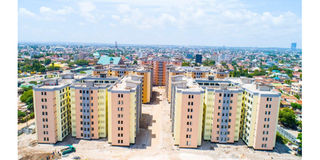Challenges of living in and managing residential tower blocks

Residential flats in Magomeni, Dar es Salaam.
What you need to know:
- The land on which the Magomeni Quarters were constructed (some 740 acres) was acquired by the (Colonial) Government in 1951 for one of the African Housing Schemes in the then Municipality of Dar es Salaam (see GN 689 of 28/4/1951). By December 1953, 450 houses had been constructed.
The conditions of the high-rise block of flats constructed in recent time on land that used to house the “Magomeni Quarters” has raised concern in the media. There is sadness that these buildings which were highlighted as a sign of modernity are showing signs of deterioration only a few years after they were commissioned.
The land on which the Magomeni Quarters were constructed (some 740 acres) was acquired by the (Colonial) Government in 1951 for one of the African Housing Schemes in the then Municipality of Dar es Salaam (see GN 689 of 28/4/1951). By December 1953, 450 houses had been constructed.
Fast forward, and cutting a very long story short, come 2016, the Government of the day decided to put up blocks of flats to house the residents of the highly deteriorated “quarters”.
Three years after they were commissioned to the 644 residents, the blocks are depreciating fast and the Tanzania Building Agency has promised to spend over Sh1 billion to address issues of deteriorating infrastructure, poor sanitation and petty crime resulting into missing (presumed stolen) components.
Is this a unique story? Not at all! Housing people in high rise buildings (Tower Blocks) in the UK in the 1960s/1970s provides good lessons.
In an article written by UK architect Clive Turner and titled: “Towers in the Sky 1960–1979”, it is observed that: “in the 1960s and 70s, to reduce the ongoing housing shortage and to re-house those in substandard homes, local authorities across the land (UK) built large numbers of residential tower blocks.
While good intentioned, in practice many of the tower blocks were social and financial failures. In the worst cases, vertical slums replaced horizontal ones”.
It was supposed that everyday people would enjoy high-rise living and share the utopian vision of an elite professional minority who precipitated this change. However, even within a few years many of these were demonstrating serious shortcomings in design and construction and were rapidly falling out of favour with the public.
Take a ferry boat and cross the channel to Zanzibar. It was reported in June 2025 that Members of the House of Representatives had raised alarm over deteriorating sanitary conditions in parts of the Michenzani Housing Complex, citing blocked drainage systems and foul odours.
Numerous studies on these Michenzani blocks found that the buildings suffer from lack of water pressure from the second floor up, necessitating residents to install their own water pumps. The design does not match local cultures and lots of modifications have been made by residents.
Over the years, the ground floor of the blocks has undergone profound transformations. Some housing units have begun to accommodate small commercial businesses at the same time as the occupation of the appurtenant spaces by kiosk shops.
Elderly residents from the upper floors have moved to this same level. Inside many apartments, walls have been added, moved and removed to facilitate the life of family units that can reach up to 13 members. Staircases are areas of socialization and storage.
I spent some 10 years in Tandika Flats which were allocated to us brand new in 1975. Each block was five-storeys high and had 20 units of two bedroomed flats. Within a short period, problems of water pressure began to arise. Residents could not afford electricity, which in any case was intermittent, so the use of firewood and charcoal became the norm.
Families, many of them large, could not afford toilet paper, resorting to the use of newspapers, which very often led to the blockage of the single stack drains. Those at the ground floor suffered the worst of blockage with sewage sometimes flooding their units.
The blocks suffered from poor maintenance, which in any case was quite expensive. So, come the 1980s, the blocks and their surroundings, that were once glittering, had deteriorated into slums. Thank God, recent years have seen some extensive repair work on these iconic buildings.
Studies of such residential tower blocks reveal similarities. Many suffer from design issues, incompatibility with social aspirations and economic capabilities of residents; but also suffer from external situation like low water pressure, intermittent electricity supply, problems with managing waste, both liquid and solid, and overall sharing of management responsibilities among residents and sometimes between residents and landlords, especially where the latter are the public sector.
The UK has pulled down many of its residential tower blocks since the 1970s, and demolition is ongoing.
High rise blocks are an intensive use of scarce space, but there needs to be a cautious approach. The blocks could be limited to the walkable five storeys, so that we have more horizontal that vertical blocks. Social, cultural and economic issues of the intended users must be taken on board
The observations about residential tower blocks in the UK, Zanzibar and Dar es Salaam are comparable. For the UK Turner observes: “In just two decades we saw the rise of the residential tower block and its fall from grace – an expensive and damaging episode”. For Michenzani: “These apartments were once a source of pride for revolutionary Zanzibar, but their current condition reflects a decline”, and for Magomeni Kota: “What was once a model of urban housing in Tanzania is now a fading symbol of opportunity lost”.
These are powerful messages. We need to rethink of the suitability of the residential Tower Blocks to our circumstances.
Lusugga Kironde is Professor of Land and Urban Economics and lead consultant at TKA Company Ltd




